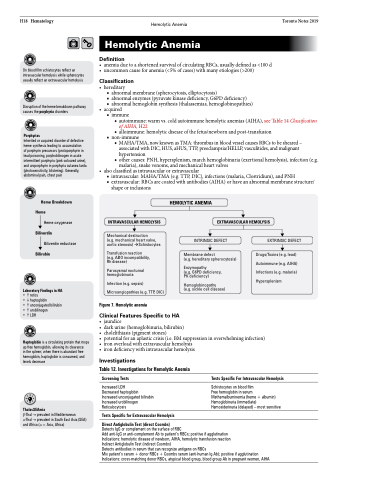Page 558 - TNFlipTest
P. 558
H18 Hematology
Hemolytic Anemia
Toronto Notes 2019
Onbloodfilmschistocytesreflectan intravascular hemolysis while spherocytes usually reflect an extravascular hemolysis
Disruption of the heme breakdown pathway causes the porphyria disorders
Porphyrias
Inherited or acquired disorder of defective heme synthesis leading to accumulation
of porphyrin precursors (protoporphyrin in lead poisoning, porphobilinogen in acute intermittent porphyria (pink-coloured urine), and uroporphyrin in porphyria cutanea tarda (photosensitivity,blistering).Generally, abdominal pain, chest pain
Heme Breakdown Heme
Heme oxygenase
Biliverdin
Biliverdin reductase
Bilirubin
Laboratory Findings in HA
• h retics
• i haptoglobin
• h unconjugated bilirubin • h urobilinogen •hLDH
Haptoglobin is a circulating protein that mops up free hemoglobin, allowing its clearance
in the spleen; when there is abundant free hemoglobin, haptoglobin is consumed, and levels decrease
ThalasSEAmia
β-Thal → prevalent in Mediterranean
α-Thal → prevalent in South East Asia (SEA) and Africa (α = Asia, Africa)
Hemolytic Anemia
Definition
• anemiaduetoashortenedsurvivalofcirculatingRBCs,usuallydefinedas<100d • uncommoncauseforanemia(<5%ofcases)withmanyetiologies(>200)
Classification
• hereditary
■ abnormal membrane (spherocytosis, elliptocytosis)
■ abnormal enzymes (pyruvate kinase deficiency, G6PD deficiency)
■ abnormal hemoglobin synthesis (thalassemias, hemoglobinopathies)
• acquired
■ immune
◆ autoimmune: warm vs. cold autoimmune hemolytic anemias (AIHA), see Table 14 Classification of AIHA, H22
◆ alloimmune: hemolytic disease of the fetus/newborn and post-transfusion ■ non-immune
◆ MAHA/TMA, now known as TMA: thrombus in blood vessel causes RBCs to be sheared – associated with DIC, HUS, aHUS, TTP, preeclampsia/HELLP, vasculitides, and malignant hypertension
◆ other causes: PNH, hypersplenism, march hemoglobinuria (exertional hemolysis), infection (e.g. malaria), snake venoms, and mechanical heart valves
• alsoclassifiedasintravascularorextravascular
■ intravascular: MAHA/TMA (e.g. TTP, DIC), infections (malaria, Clostridium), and PNH
■ extravascular: RBCs are coated with antibodies (AIHA) or have an abnormal membrane structure/
shape or inclusions
INTRAVASCULAR HEMOLYSIS
Mechanical destruction
(e.g. mechanical heart valve, aortic stenosis)Schistocytes
Transfusion reaction (e.g. ABO incompatibility, Rh disease)
Paroxysmal nocturnal hemoglobinuria
Infection (e.g. sepsis) Microangiopathies (e.g. TTP, DIC)
Figure 7. Hemolytic anemia
Clinical Features Specific to HA
HEMOLYTIC ANEMIA
EXTRAVASCULAR HEMOLYSIS
INTRINSIC DEFECT
Membrane defect
(e.g. hereditary spherocytosis)
Enzymopathy
(e.g. G6PD deficiency, PK deficiency)
Hemoglobinopathy
(e.g. sickle cell disease)
EXTRINSIC DEFECT
Drugs/Toxins (e.g. lead) Autoimmune (e.g. AIHA) Infections (e.g. malaria) Hypersplenism
• jaundice
• darkurine(hemoglobinuria,bilirubin)
• cholelithiasis(pigmentstones)
• potentialforanaplasticcrisis(i.e.BMsuppressioninoverwhelminginfection) • ironoverloadwithextravascularhemolysis
• irondeficiencywithintravascularhemolysis
Investigations
Table 12. Investigations for Hemolytic Anemia
Screening Tests
Increased LDH
Decreased haptoglobin Increased unconjugated bilirubin Increased urobilinogen Reticulocytosis
Tests Specific for Extravascular Hemolysis
Direct Antiglobulin Test (direct Coombs)
Tests Specific For Intravascular Hemolysis
Schistocytes on blood film
Free hemoglobin in serum Methemalbuminemia (heme + albumin) Hemoglobinuria (immediate) Hemosiderinuria (delayed) – most sensitive
Detects IgG or complement on the surface of RBC
Add anti-IgG or anti-complement Ab to patient’s RBCs; positive if agglutination
Indications: hemolytic disease of newborn, AIHA, hemolytic transfusion reaction
Indirect Antiglobulin Test (indirect Coombs)
Detects antibodies in serum that can recognize antigens on RBCs
Mix patient’s serum + donor RBCs + Coombs serum (anti-human Ig Ab); positive if agglutination Indications: cross-matching donor RBCs, atypical blood group, blood group Ab in pregnant women, AIHA


